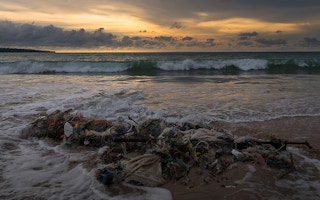The great mass of castaway plastic collecting in the northern Pacific Ocean is much larger than past estimates, and it’s growing, according to a new study.
As a species, we use and discard millions of tons of plastic each year, and a lot of it ends up in the ocean, where researchers estimate that it kills or injures 100,000 marine animals each year. And while some of it gets broken up and sinks, scientists have found that gyres — swirling areas in the world’s oceans where circulating currents meet — collect a lot of this waste.
A recent survey of the Great Pacific Garbage Patch, the largest of these collections, revealed that the aggregated plastic there weighs in at 79,000 metric tons (87,100 short tons). That’s between four and 16 times heavier than past estimates. As we continue to produce even more plastic, the patch is growing exponentially heavier by the year, according to measurements of its size over time.
What’s more, most of the plastic, floating across an area larger than Mongolia at 1.6 million square kilometers (618,000 square miles), are pieces that are larger than 5 centimeters (2 inches) in length, and some 46 per cent of the total mass is made up of old fishing nets. These “ghost nets” effectively become deadly floating traps for all kinds of sea life.
“I knew there would be a lot of fishing gear, but 46 per cent was unexpectedly high,” Laurent Lebreton, an oceanographer with the nonprofit organization Ocean Cleanup and lead author of the paper, said in an interview with National Geographic News. “Initially, we thought fishing gear would be more in the 20 per cent range.”
But in fact, better than half of the debris that the team cataloged came from boats and ships at sea. The patch sits between Hawaii and California. Scientists think that it has collected so much plastic because of its location adjacent to the densely populated eastern shores of Asia and in an area that humans fish heavily.
“
The interesting piece is that at least half of what they’re finding is not consumer plastics, which are central to much of the current debate, but fishing gear.
George Leonard, marine ecologist
Laurent and his team were able to come up with a more comprehensive assessment of the composition of the Great Pacific Garbage Patch by adding a new dimension to their investigation. They shared their results on March 22 in the journal Scientific Reports.
Previous probes of the garbage patch relied primarily on sampling nets and visual surveys of the garbage patch from boats. For this research, the team also took photographs of the patch from an airplane. From this bird’s-eye view, they write, they were able to more accurately count the large pieces of plastic, such as fishing nets or bottles.
They also sifted through more than 1.1 million pieces of debris from over 650 boat-based sampling trips. Virtually everything they picked up from the massive flotilla of garbage was plastic. And even though bigger pieces accounted for most of the heft, the scientists calculated that small bits called microplastics account for 94 per cent of the 1.8 trillion pieces of plastic in the patch.
Microplastics include additives found in some cosmetics, as well as stubborn fragments of larger, degrading plastic pieces. Small organisms like plankton and fish can ingest these tiny shards, and they’re in turn eaten by larger animals. Microplastics shimmy their way up the food chain until they reach the ocean’s top predators, where they could play havoc with their digestive systems. Once there, they also break down into toxic compounds, potentially causing serious health problems for animal species that are already battling other threats to their survival.
Another recent study highlighted the danger that microplastics pose to filter feeders like manta rays and the world’s largest fish, the whale shark (Rhincodon typus).
The Ocean Cleanup, based in the Netherlands, has launched a multimillion-dollar effort to develop the technology necessary to clear away half of the Great Pacific Garbage Patch in the next five years. Now, with the nuanced understanding of the plastics that are trapped there that this new research provides, scientists say, we have a better idea of how to prevent our trash from ending up there in the first place.
“The interesting piece is that at least half of what they’re finding is not consumer plastics, which are central to much of the current debate, but fishing gear,” marine ecologist George Leonard said in the National Geographic News article. Leonard, the chief scientist at the Ocean Conservancy, was not involved with this research.
“This study is confirmation that we know abandoned and lost gear is an important source of mortality for a whole host of animals and we need to broaden the plastic conversation to make sure we solve this wedge of the problem,” he said.
This story was published with permission from Mongabay.com. Read the full story.










